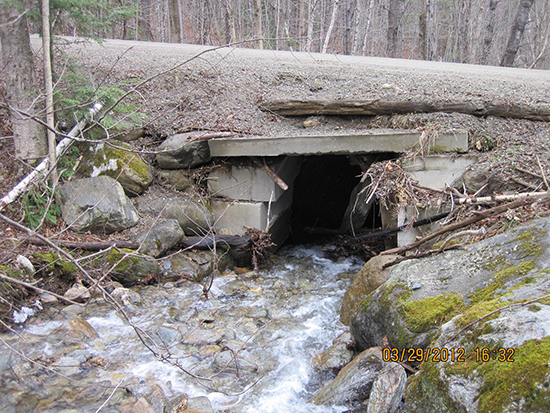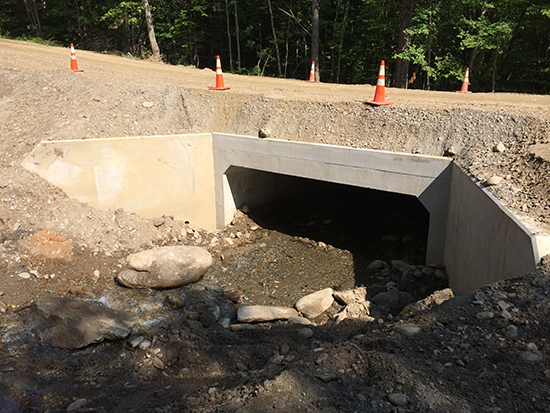A new, larger and improved culvert now allows Lockwood Brook to pass beneath Manlin Road in Fayston. The old culvert – a combo of corrugated metal pipe and concrete – was too small for the Lockwood Brook system and during Tropical Storm Irene (and other storms) damming by debris and overtopping floodwaters caused major damage to private property and town road infrastructure.
This summer, the Fayston road crew installed a concrete box culvert engineered to state standards and designed to pass regular floods as well as fish. The old culvert caused flooding but also blocked aquatic organisms moving upstream. A drop at the culvert outlet, high in-culvert water velocity, or shallow in-culvert water depth can cause problems for trout as they try to reach their upstream habitat.
The new culvert is the right size for the stream and is embedded with a natural channel bottom, allowing fish movement. "Access to upstream habitat is important for trout species in the face of a warming climate because upstream habitat offers the cooler water they need for survival," said Friends of the Mad River director Corrie Miller.

"The U.S. Fish and Wildlife Service is pleased to be part of such a successful project that benefits both aquatic habitat for brook trout and town highway infrastructure," said Chris Smith, a U.S. Fish and Wildlife Service biologist.
Since Irene, Friends of the Mad River (FMR) has been working with watershed municipalities and state and federal partners to identify culverts that are problematic from both a flooding and fish habitat perspective.
"Since we have limited resources, replacing these culverts is 'win-win' because it helps towns improve their infrastructure to be more flood resilient and builds habitat for trout," said Miller. In conversations after Irene, the town of Fayston pinpointed the Manlin Road problem culvert and planning began for replacing it.
"This culvert was a real problem," said Stuart Hallstrom, Fayston's road foreman. "We're glad to be able to do something about it."
Flood resilience funding from America's Great Outdoors Initiative catalyzed the project, then Vermont Department of Fish and Wildlife and U.S. Fish and Wildlife Service contributed additional funding and technical assistance. To keep the costs down, Fayston's road department committed to doing the construction work while Friends of the Mad River managed the project.
"It was a true team effort and, after securing approximately $100,000 in state and federal funding and significant additional local commitment in time and energy, the design and construction began," Miller added.
Now, construction work is complete and the appropriately sized culvert is in place. "The select board is pleased with the outcome of this project," said Jared Cadwell, Fayston Select Board chair. "It posed technical challenges, but we applaud our road crew for its ability to meet them. We also greatly appreciate Corrie Miller's diligence and collaboration." Friends of the Mad River will coordinate the site's rehabilitation this fall with tree and shrub plantings.
For more information about efforts to build flood resilience and aquatic organism passage in the Mad River watershed, contact Friends of the Mad River.
{loadnavigation}







